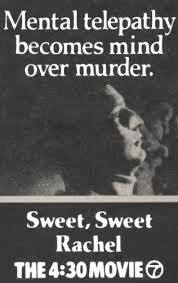In
the 1971 TV movie, Sweet, Sweet Rachel, celebrity musician Paul Stanton (Rod
McCarey) dies under unusual circumstances, jumping out the window of his
seaside mansion.
His
beautiful young wife, Rachel (Stefanie Powers) witnesses the fall, and receives
a mysterious phone call immediately afterwards.
She becomes convinced that she is responsible for her husband’s death.
Rachel
visits Dr. Lucas Darrow (Alex Dreier), an expert in parapsychology, who
believes that she is actually a victim of “constant
psychic harassment.” Perhaps she is even
being framed for the murder of her husband. The first order of business is to
find the mysterious phone caller.
Dr.
Darrow and a blind sensitive with ESP, Carey Johnson (Chris Robinson)
investigate Paul and Rachel Stanton, and learn that Rachel’s mother, Lillian
(Louise Latham) seems to possess the ability to communicate with the dead.
When
Lillian turns up dead, however, Rachel is suspected by the police, but Darrow
and Carey look at her uncle Arthur (Pat Hingle), and his daughter Nora (Brenda
Scott), who may also possess psychic abilities.
Created
by Anthony Lawrence, Sweet, Sweet Rachel is the backdoor
pilot for the 1972 “psychic” sci-fi series, The Sixth Sense
(1972-1973). That series, which was
cut-up badly and syndicated in half-hour format as part of Rod Serling’s Night Gallery
(19701-1973), involves a handsome (but
oh so bland…) parapsychologist, Dr. Michael Rhodes (Gary Collins), and his
encounters with people (usually lovely young women) who are being manipulated
by people with psychic abilities.
Sweet,
Sweet Rachel
is intriguing for spearheading the premise of the series, but also for featuring
a more intriguing cast than its successor. Dreier’s Dr. Darrow is a portly,
grave man with a solemn demeanor and a baritone voice. He isn’t your typical
1960s-1970s “handsome” or athletic series lead, and he brings an incredible
gravitas to the role.
Similarly,
Dr. Darrow gets a sidekick, which Rhodes never did, at least not on a regular
basis. Early in Sweet, Sweet Rachel, Darrow
recounts the story of how he received a “psychic message” from one of his
patients, Carey, while in surgery for another patient. His receipt of this message led to the
beginning of their friendship, but also the beginning of his fascination with
the paranormal. This is more background,
incidentally, than The Sixth Sense ever really provided about Dr. Rhodes. It’s nice to get that information here, in
the form of a flashback.
But
it works well for this movie (and this format, which The Sixth Sense adopts…)
to have the lead doctor teamed with an actual sensitive; so they can bounce
ideas back and forth. Here, the real
murderer is outed only after Darrow hypnotizes Carey, and Carey attempts to
reach out with ESP to contact the killer. In The Sixth Sense, Rhodes
works alone, and is psychic himself.
Intriguingly,
Sweet
Sweet Rachel may also qualify as a film noir, at least in terms of its
style and general subject matter (murder). The film’s lighting is extremely
dark and expressionistic, and the subject matter is a crime of passion, but
with a psychic twist. Those conspiring to frame Rachel and make her look
insane, are out for their own financial gain, although one of Paul’s murderers
was also in love with him. The killers
are avaricious schemers who operate from the shadows, and must finally be
exposed.
The
central detective, in this case, Darrow, becomes involved in the case in a most
personal way. He is nearly a victim --
in the film’s most tense scene -- of a psychic assassination as well.
Suspense
mounts as the psychic assassin takes control of Darrow, causes him to wreck his
car, and then nearly makes him light a match in his gas tank. Finally Carey --
fumbling in the dark -- stops Darrow from blowing them both up. This scene
remains quite effective, even today, and suggests the power of the psychic
assassin (perhaps too effectively).
This
TV-movie also has much in common with its follow-up The Sixth Sense, in a negative way. The telefilm’s storyline is
muddled and unnecessarily complicated, and those who possess psychic powers
are, as suggested by my previous paragraph, practically all-powerful. Sweet
Sweet Rachel is filmed well, and short at roughly 71 minutes, and yet
it feels long and slow, and occasionally incoherent. It has a plodding nature
to it, somehow.
This
telefilm film was quite popular in 1971, and is well-regarded historically, which
is why the concept became a weekly series, I suppose. It is not difficult to
discern how viewers must have tuned in, and been immediately grabbed by the
colorful death scene in the preamble.
The film’s prologue, with Paul practicing his ESP skills, and then
experiencing a vision that sends him to his death, remains absolutely chilling,
and well-orchestrated. The rest of the
movie, other than the psychic assassination scene, is a bit of a letdown in
comparison to the stylish opening murder.
This
was a key flaw, as well, of The Sixth Sense. The psychic death
scenes were always incredibly inventive, but the rest of the narrative always
seemed like repetitive, tired melodrama.
Today, after screening Sweet Sweet Rachel, I have to wonder
if the follow-up series might have done better with a less photogenic, but more
interesting lead character (Darrow), and his sidekick sensitive, Carey. They are interesting enough people to follow
through a weekly series, and they might have made the stories of The
Sixth Sense a bit less dull.
It
is intriguing, finally, that this telefilm is called Sweet, Sweet Rachel,
since Rachel is a bit of a passive character, always acted upon, never acting
for herself.








No comments:
Post a Comment